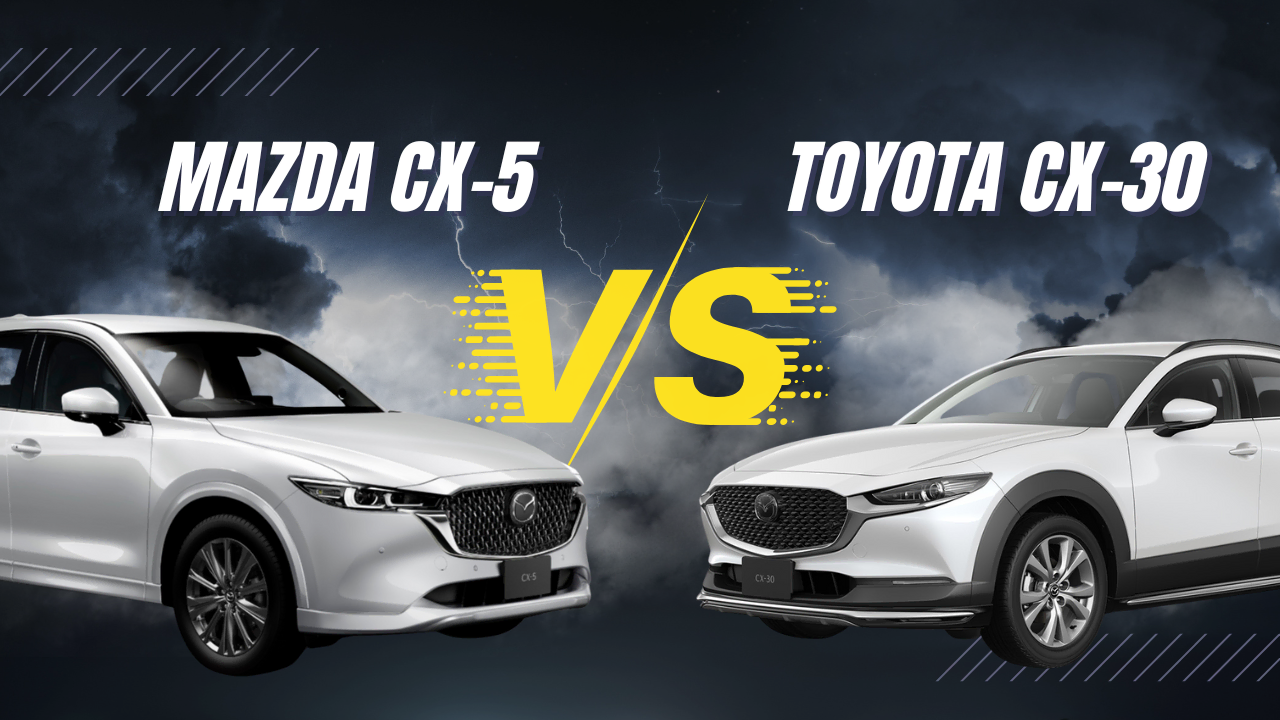
When shopping for a Mazda crossover, the CX-5 and CX-30 often come to mind due to their stylish designs, advanced features, and strong performance. While they share Mazda’s signature KODO design language and cutting-edge Skyactiv technology, these models cater to different lifestyles and driving preferences. Let’s compare the Mazda CX-5 and CX-30 across key aspects to help you choose the best fit.
1. Dimensions & Design
Mazda CX-5
- Type: Compact SUV
- Dimensions: 4550 x 1840 x 1675 mm
- Design Highlights: Elegant yet rugged, with bold front grilles, slim LED headlights, and sporty curves.
Mazda CX-30
- Type: Subcompact Crossover SUV
- Dimensions: 4395 x 1795 x 1540 mm
- Design Highlights: Sleek and modern with a coupe-like roofline, sporty stance, and distinctive wheel arch cladding.
The Mazda CX-5’s robust design emphasizes strength and durability, making it ideal for adventurous drivers. Its bold grille and sculpted sides project a commanding presence on the road. In contrast, the CX-30’s coupe-inspired profile highlights its urban-friendly character, with dynamic curves that make it stand out in city environments.
Verdict: If you prefer a more spacious and commanding presence, the CX-5 stands out. The CX-30 is better for those who want a stylish, city-friendly vehicle.
2. Performance & Efficiency
Mazda CX-5
- Engines: 2.5L Skyactiv-G (187 HP) or turbocharged (up to 256 HP)
- Fuel Efficiency:
- Petrol: 12-14 km/L
- Diesel: 15-18 km/L
- Hybrid: 16-18 km/L
- Transmission: 6-speed automatic with optional AWD
Mazda CX-30
- Engine: 2.5L Skyactiv-G (186 HP)
- Fuel Efficiency:
- Petrol: 12-14 km/L
- Diesel: 15-17 km/L
- Hybrid: 17-19 km/L
- Transmission: 6-speed automatic with available AWD
The Mazda CX-5 is a top choice for those seeking a more powerful and dynamic driving experience. With its available turbocharged engine, it can handle challenging terrains and offer smooth highway acceleration. The CX-30, on the other hand, is designed for nimble urban maneuvering, providing responsive steering and tight handling, making every drive enjoyable.
Verdict: The CX-5 delivers more power and towing capacity, making it suitable for adventure seekers. The CX-30 balances efficiency and agility, ideal for daily commuting.
3. Interior & Cargo Space
Mazda CX-5
- Seating: 5 passengers
- Cargo Space: 30.9 cu ft (rear seats up); 59.6 cu ft (seats down)
- Key Features: Premium upholstery, 8-way power driver’s seat, advanced infotainment system, and generous legroom.
Mazda CX-30
- Seating: 5 passengers
- Cargo Space: 20.2 cu ft (rear seats up); 45.2 cu ft (seats down)
- Key Features: Refined cabin materials, leather-trimmed seats, and modern tech integrations.
Inside the CX-5, passengers enjoy a spacious and comfortable environment with available leather upholstery, dual-zone climate control, and heated seats. The CX-30’s interior emphasizes modern elegance with contrasting trim, ergonomic controls, and a driver-centric dashboard.
Verdict: The CX-5 wins in space and utility, while the CX-30 excels in offering a premium feel in a smaller package.
4. Safety & Technology
Both models come equipped with Mazda’s i-Activsense safety suite, including:
- Adaptive cruise control
- Lane-departure warning
- City emergency braking
- Blind-spot monitoring
Additionally, both offer a user-friendly infotainment system with smartphone integration, premium sound systems, and navigation options.
The CX-5 includes additional features such as a 360-degree camera, front and rear parking sensors, and an advanced driver alert system. The CX-30 complements its safety features with automatic high beams, driver attention monitoring, and traffic sign recognition for added convenience.
Verdict: It’s a tie, as both models provide advanced safety and tech features designed for peace of mind.
5. Pricing
- Mazda CX-5: $2,620 – $11,220 (used, average BE Forward pricing)
- Mazda CX-30: $9,180 – $21,320 (used, average BE Forward pricing)
While the CX-5 offers competitive pricing for a feature-rich compact SUV, the CX-30 provides great value for buyers seeking a stylish and modern crossover. Trim levels, optional packages, and engine upgrades can influence final pricing.
Verdict: Budget-conscious buyers may find the CX-5 more affordable, while those seeking a newer design with premium options might prefer the CX-30.
Final Thoughts
Choosing between the Mazda CX-5 and CX-30 ultimately comes down to your specific driving needs. The CX-5 offers more space, power, and utility, making it a top choice for families and adventurers. The CX-30 shines as a stylish, efficient, and tech-savvy option perfect for urban lifestyles.
Whether you prioritize space, performance, or style, Mazda’s crossovers provide versatile solutions for modern drivers.

